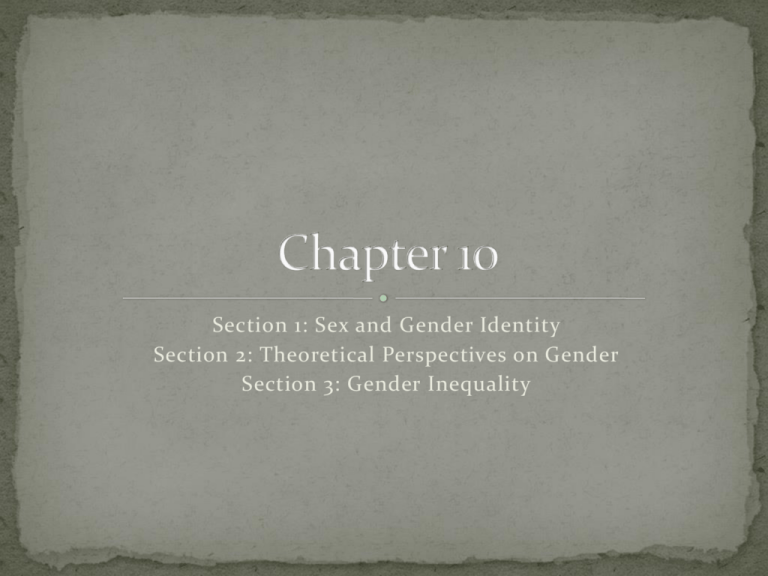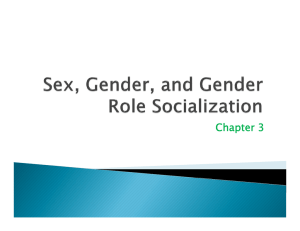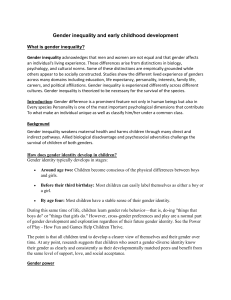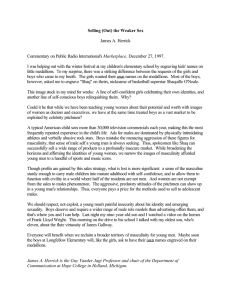File
advertisement

Section 1: Sex and Gender Identity Section 2: Theoretical Perspectives on Gender Section 3: Gender Inequality …distinguish the concepts of sex, gender, and gender identity. …summarize the perspectives on gender taken by functionalists, conflict theorists, and symbolic interactionists …compare/contrast the ways in which functionalism, conflict theory, and symbolic interactionism approach ageism. …discuss inequality experienced by America’s elderly. What are little girls made of? Sugar and Spice And everything nice. That’s what little girls are made of. What are little boys made of? Snips and snails And puppy dog tails That’s what little boys are made of. If men and women behave differently, it is assumed it is because of their sex – classification of people as male/female based on biological characteristics Men more masculine/aggressive Women more passive/nurturing Biological determinism – Gender Identity – a sense the belief that behavioral differences are the result of inherited physical characteristics. (Men are born to act one way and women another) of being male or female based on learned cultural values. Nature vs. Nurture Biology may create tendencies, but they are overridden by cultural/social influences Are male/female brains different? Slightly, in structure and activity Do these differences lead to different social behavior? Continued debate Female babies are more sensitive to sound Male children more active in play Men tend to prefer younger women, Women, older men Sociologist view on behavior Gender-related behavior not primary the result of biology, rather culture and socialization Studies suggest gender roles are not fixed at birth Safe to conclude that human behavior is the result of multiple causes Functionalism and Gender Any patter of behavior that does not benefit society will become unimportant Division of responsibilities and labor benefits society Women more valuable than men in the sense of reproduction Traditional divisions of labor has created problems for modern society (inequalities) It is to men’s advantage to prevent women from gaining equal resources Traditional gender roles are outdated Women who prefer careers in fields formerly reserved for men have every right to make that choice, regardless of its functionality Focus on how boys/girls learn to act the way they are “supposed to act.” Gender socialization – the social process of the learning to act as a boy or girl. Parents are vital to this process; begins at birth Gender taught through chores, etc The role of the school Different behaviors encourage in first years of schools for boys/girls Studies suggest that the educational system often shortchanges females and dampens female competitiveness – systematically taught to be passive, dislike math/science and defer to boys Peers Influences Gender Wage Gap What stands in the way of women being equal to men? BBC News Women as a Minority Group Sexism – a set of beliefs, attitudes, norms, and values used to justify sexual inequality Sexist Ideology – belief that men are naturally superior to women – Does it exist? Isn’t sex discrimination disappearing? Positions of power, closing gap in equality 2004 – 59% of women worked outside the home, making up over 46% of the workforce Married women w/children under age of 6 – 19% in 1960, 37% in 1975, 59.3% in 2004. Kinds of Jobs Occupational sex segregation – the concentration of women in lower-status positions Women occupy nearly all “pink-collar” jobs (support jobs) Do women earn less? $.80 to every dollar a male earns Worse for women of minority race/ethnicity Some states refused women the right to keep their own surnames after marriage Protective legislation restricting women’s right – limiting the number of hours women could work. Also limited the conditions in which they could work, and limiting the kinds of work women could do by regulating such matters as amount of weight a would could be permitted to lift Title VII (Civil Right Act of 1964) nullified such laws Women more likely to take maternity leave How does this impact the hiring process Women have increased political representation over the years, but still hold a relatively small proportion of important political positions.(15.4% of the seats in the House of Rep. in 2005, 14% of senate seats) European countries have greater representation Power elite is no longer exclusive, but still limiting to females – many who do join the power elite come from upper-class backgrounds Political Cartoon Analysis Google Classroom











